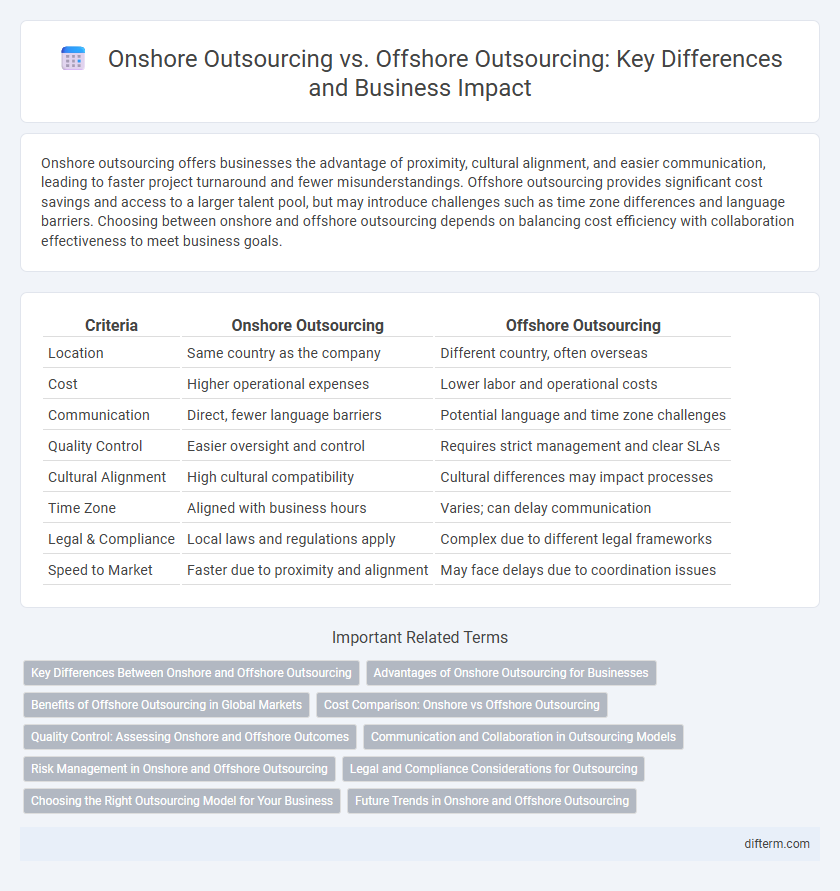Onshore outsourcing offers businesses the advantage of proximity, cultural alignment, and easier communication, leading to faster project turnaround and fewer misunderstandings. Offshore outsourcing provides significant cost savings and access to a larger talent pool, but may introduce challenges such as time zone differences and language barriers. Choosing between onshore and offshore outsourcing depends on balancing cost efficiency with collaboration effectiveness to meet business goals.
Table of Comparison
| Criteria | Onshore Outsourcing | Offshore Outsourcing |
|---|---|---|
| Location | Same country as the company | Different country, often overseas |
| Cost | Higher operational expenses | Lower labor and operational costs |
| Communication | Direct, fewer language barriers | Potential language and time zone challenges |
| Quality Control | Easier oversight and control | Requires strict management and clear SLAs |
| Cultural Alignment | High cultural compatibility | Cultural differences may impact processes |
| Time Zone | Aligned with business hours | Varies; can delay communication |
| Legal & Compliance | Local laws and regulations apply | Complex due to different legal frameworks |
| Speed to Market | Faster due to proximity and alignment | May face delays due to coordination issues |
Key Differences Between Onshore and Offshore Outsourcing
Onshore outsourcing involves delegating business processes to service providers within the same country, ensuring cultural alignment, easier communication, and compliance with local regulations. Offshore outsourcing transfers tasks to overseas companies, often resulting in significant cost savings but potential challenges related to time zone differences, language barriers, and varying legal frameworks. Key differences between onshore and offshore outsourcing include cost-effectiveness, communication efficiency, quality control, and regulatory adherence.
Advantages of Onshore Outsourcing for Businesses
Onshore outsourcing offers businesses improved communication and collaboration due to shared time zones and cultural similarities, leading to increased project efficiency and faster decision-making. It minimizes risks related to data security and compliance with local regulations, ensuring better control over sensitive information. Proximity to service providers allows easier management and quality assurance, enhancing overall service reliability and customer satisfaction.
Benefits of Offshore Outsourcing in Global Markets
Offshore outsourcing offers significant cost savings by leveraging lower labor expenses in countries such as India, the Philippines, and Vietnam, enabling businesses to reduce operational costs while maintaining quality. Access to a global talent pool allows companies to tap into specialized skills and innovative technologies, accelerating project timelines and enhancing competitiveness. Furthermore, offshore outsourcing supports 24/7 operations through diverse time zones, ensuring continuous productivity and faster turnaround for global market demands.
Cost Comparison: Onshore vs Offshore Outsourcing
Onshore outsourcing typically involves higher labor and operational costs due to domestic wage standards and regulatory compliance, but it offers advantages in communication and cultural alignment. Offshore outsourcing presents a significant cost reduction by leveraging lower wages and operational expenses in foreign markets, often resulting in savings of 30% to 70%. However, hidden costs such as time zone differences, management complexity, and potential quality control issues can impact the overall cost-effectiveness of offshore outsourcing.
Quality Control: Assessing Onshore and Offshore Outcomes
Onshore outsourcing offers improved quality control through closer proximity, enabling real-time collaboration and faster issue resolution, which often leads to higher adherence to standards and project requirements. Offshore outsourcing may reduce costs but poses challenges in maintaining consistent quality due to time zone differences, cultural barriers, and communication gaps. Businesses prioritizing quality control typically favor onshore partnerships for better oversight and alignment with organizational objectives.
Communication and Collaboration in Outsourcing Models
Effective communication and seamless collaboration are critical in onshore outsourcing, where geographic proximity and shared time zones facilitate real-time interactions and quick issue resolution. Offshore outsourcing often faces challenges such as language barriers and time zone differences, which can lead to misunderstandings and delayed responses, impacting project timelines and quality. Implementing robust communication tools and clearly defined collaboration protocols enhances coordination in both models, but onshore outsourcing inherently supports smoother and more synchronous teamwork.
Risk Management in Onshore and Offshore Outsourcing
Onshore outsourcing minimizes risks related to communication barriers, time zone differences, and regulatory compliance by leveraging local expertise and legal frameworks. Offshore outsourcing faces higher risks such as cultural misunderstandings, data security vulnerabilities, and intellectual property protection challenges, requiring robust governance and risk mitigation strategies. Effective risk management in both models hinges on thorough vendor due diligence, clear contract terms, and ongoing performance monitoring.
Legal and Compliance Considerations for Outsourcing
Onshore outsourcing offers greater legal transparency and easier compliance with domestic regulations, reducing risks related to data protection and labor laws. Offshore outsourcing often involves navigating complex international legal frameworks, including varying intellectual property protections and differing standards for data privacy compliance under regulations such as GDPR or CCPA. Businesses must conduct thorough due diligence and implement stringent contracts to mitigate risks associated with regulatory breaches and ensure alignment with industry-specific compliance requirements.
Choosing the Right Outsourcing Model for Your Business
Choosing the right outsourcing model for your business depends on factors such as cost efficiency, control, and quality requirements. Onshore outsourcing offers proximity, easier communication, and cultural alignment, ideal for projects needing close collaboration and quick turnaround. Offshore outsourcing provides significant cost savings and access to a global talent pool but requires managing time zones and potential language barriers.
Future Trends in Onshore and Offshore Outsourcing
Future trends in onshore outsourcing emphasize increased integration of advanced automation technologies and artificial intelligence to enhance service quality and reduce operational costs. Offshore outsourcing is poised to evolve with a growing focus on strategic partnerships in emerging markets, driven by improved digital infrastructure and evolving regulatory frameworks. Both models will increasingly adopt hybrid outsourcing strategies to balance cost efficiency with agility and innovation in a dynamic global business environment.
Onshore Outsourcing vs Offshore Outsourcing Infographic

 difterm.com
difterm.com